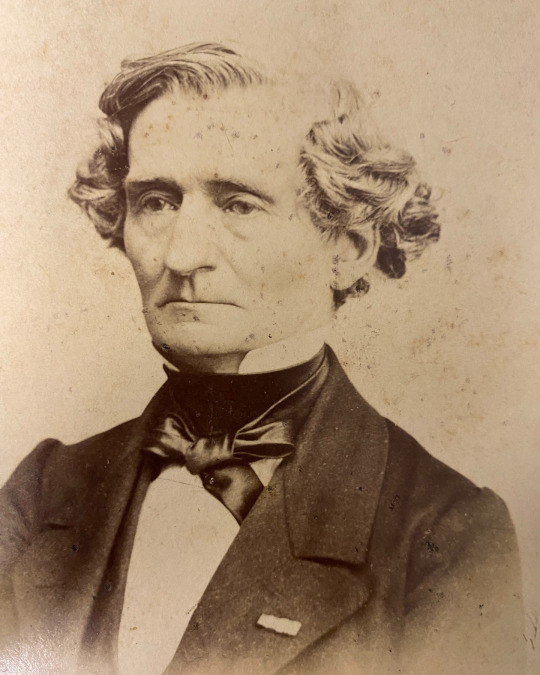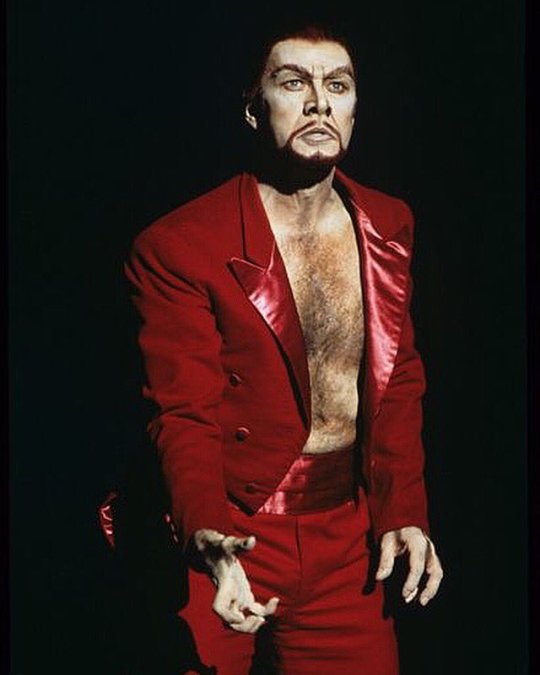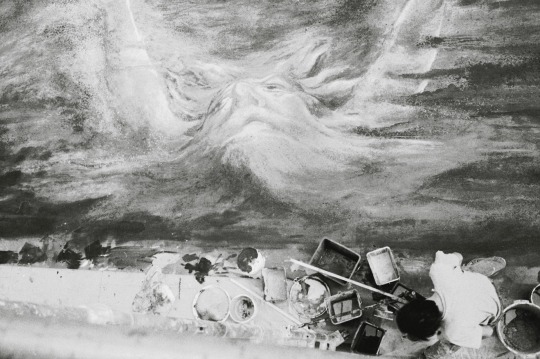#berlioz faust
Text
thinking about berlioz faust, specifically thinking that if you're going to do a fully staged version you should get the guy who did the 2010 Massenet Werther on the case
he could just do the exact same thing again



Gretchen / Faust / Devil

interiors

exteriors


here just replace snow with roses and charlotte with the devil
voilà, perfect berlioz faust.
5 notes
·
View notes
Text
YOU GUYS. Normally the symphony broadcasts don't get put up in full after the fact, but they're doing it with our performance of La Damnation de Faust from a couple of weeks ago, because it was JUST THAT FABULOUS. You should go listen to it because it was an amazing set of performances and all our soloists were brilliant and very hot.
#choir stuff#berlioz#la damnation de faust#omg i'm so excited about this#i'm gonna record the audio first chance i get#not sure how long it'll be up#soloists were michael spyres as faust#john relyea as mephistopheles#isabel leonard as marguerite#and patrick guetti as brander
38 notes
·
View notes
Text
i’m sorry WHY is this so funny
#opera tag#opera#la damnation de faust#the damnation of faust#michael spyres#tenors…#berlioz#hector berlioz#IT’S SO FUNNY THOUGH
27 notes
·
View notes
Text

youtube
11 notes
·
View notes
Text


OTD in Music History: Nineteen-year-old Hector Berlioz (1803 – 1869) makes the first of what will become many contributions to the musical press when he publishes a letter in “Le Corsaire” in 1823, defending French opera against what he sees as “incursions” from Italian opera within the Parisian musical scene. (Berlioz contended that “all of [Giacchino] Rossini’s [1792 – 1868] operas put together” cannot withstand comparison with “even a few bars” of the works of Christoph Willibald Gluck [1714 – 1787] or Gaspare Spontini [1774 – 1851]. History has not endorsed this view.)
The son of a provincial French doctor, Berlioz attended a Parisian medical college before defying his family’s wishes and becoming a musician. He briefly moderated his style to win the famous "Prix de Rome" in 1830, but, as he later attested, he “learned very little” during his years at the Paris Conservatoire and he ultimately charted “his own course.” For many years, opinion remained sharply divided between those who hailed him as an original genius, and those who argued that his music lacked both form and coherence.
Berlioz completed three operas. The first, “Benvenuto Cellini” (1838) was a flop. The second, a huge epic entitled “Les Troyens” (“The Trojans,” 1858), was never staged in its entirety during his lifetime -- today some consider it to be one of the greatest operatic masterpieces of all time, while some hardly consider it at all. The third, “Béatrice et Bénédict” (1863), was actually a success at its premiere… but it has never truly entered the standard operatic repertoire.
Later in his career, Berlioz increasingly turned to conducting (he was one of the first “modern” conductors), and, to support himself, he also wrote voluminous amounts of criticism (he is generally regarded as one of the greatest music critics in history). His “Treatise on Instrumentation” (1844) was and remains a landmark work.
PICTURED: A lovely cabinet photo of Berlioz, published in Paris in the 1890s.
#opera#classical music#music history#bel canto#composer#classical composer#aria#classical studies#Hector Berlioz#Berlioz#classical musician#classical musicians#classical history#chest voice#historian of music#maestro#musician#musicians#Romantic composer#La Damnation de Faust#Paris Conservatoire#Orchestra#symphony#Overture#Oratorio#Huit scènes de Faust#Chamber music#Nocturne
13 notes
·
View notes
Text
The Devils I Know - Number 12
Welcome to “The Devils I Know!” For this spooky time of year, from now till Halloween, I’ll be counting down My Top 31 Depictions of the Devil, from movies, television, video games, and more! Today’s Devil is an operatic villain…literally!
Number 12 is Samuel Ramey. (pauses) Just…just Samuel Ramey.

Now, the chances are VERY high that if you’re reading this, your immediate thought is, “Who is Samuel Ramey?” The answer is simple: Samuel Ramey is a performer – a singer and actor – who is probably most well-known to general audiences for his voicework in things like “Over the Garden Wall.” Beyond that, he’s most renowned for his work in opera.
Having said this, before I continue talking about this entry, I need to make one thing clear: I’m not a big opera buff. I respect and admire opera immensely, and I don’t believe the old cliché that “opera is boring” has much merit…but the simple and fundamental problem is that most of the great operas are written in any language but English. Which wouldn’t be a problem if it weren’t for the fact that I, personally, don’t understand any language BUT English. Seriously. I’m terrible with other languages; I can’t even speak or understand much Spanish, and I live about a hop skip and a jump away from the Mexican border. I took a French course in High School, and I think I’ve forgotten everything I learned there. It all goes in one ear and out the other. So, unless I’m watching a video with subtitles, and I’m REALLY riveted to what’s going on, I’m just not going to really “get” what I’m watching.
Thankfully, I’ve seen Ramey’s performances in such situations. Ramey is a renowned performer with many credits under his belt, but he’s probably most well-known for playing one role, which he has effectively made a career out of, and that is the Devil. More specifically, Mephistopheles in numerous productions of Faust…and with numerous librettos. In the world of opera, you see, there are no less than THREE separate operatic versions of the Faust legend, ALL of which are VERY highly respected and frequently performed. In order of when they were composed, there’s “La Damnation de Faust,” by Berlioz; Gonoud’s “Faust;” and Boito’s “Mefistofele.” All three of these tell the exact same story, with basically the exact same plot, but with obvious minor differences between each one. I like to call them “The Three Devils of Opera.”
Ramey has played Mephistopheles in productions of all three of these operas, and in all three cases, he has done so more than once. While the music and lyrics and some scene elements may change, his portrayal of the Devil in each of these is consistent. And when I think of Mephistopheles in ANY of these shows, it’s usually Ramey I think of. Ramey’s Mephistopheles is a figure of true fantastical power; he’s a grand and show-stealing figure who is impossible to take your eyes off of, and the simple fact this actor has played this same role in so many shows for so many years really does help to make him noteworthy. It’s the operatic equivalent of, say, Mark Hamill as the Joker: Hamill has not only played the same character for many years, but in many different adaptations, and every single time he’s awesome. Ramey is exactly the same with his portrayal of Faust’s tempter and deceiver. He’s become so well-known in the part, that Ramey actually went on a touring concert once singing different songs in his repertoire; the concert was appropriately called “A Date with the Devil.” Indeed, one could argue The Beast from “Over the Garden Wall” – his most well-known performance beyond the hallowed halls of opera – is really just another example of Ramey playing the Devil, given the way the fiendish monster is portrayed in the miniseries.
If you’re not into opera, watching or listening to any of Ramey’s performances probably won’t change your mind. However, for those who are interested, just to get you started…there are recordings of Ramey’s full performances from productions of “Faust” and “Mefistofele” available on YouTube (as of when I typed this, anyway). The former was recorded and aired on television and in theatres in 1995; the latter came earlier in 1989. In my opinion, these are the two finest examples of Ramey’s work with the Devil. Check them out as soon as you can. :)
Tomorrow, the countdown continues with Number 11!
HINT: An Eggs-asperatingly Evil Fellow.
#the devils i know#top 31 devils#fiction#best#favorites#list#countdown#october special#halloween advent calendar#theatre#opera#faust#mefistofele#la damnation de faust#gonoud#berlioz#boito#samuel ramey#number 12#mephistopheles
17 notes
·
View notes
Note
Good afternoon/evening Mr Liszt :) I was listening to Symphonie fantastique and I was wondering if Totentanz was inspired by it?
Good morning my dear pupil.
I suppose listening to the Songe d'une nuit de sabbat sparked this doubt.
Although our very strong friendship certainly has had some effect on the both of us - "Hamlet" he used to call me, Hector a fervent atheist with the strongest mystical experiences I have ever encountered - I'd suppose the clearest bond between our musical choices would be his idea to include the Hungarian march in La damnation de Faust, with all that the Ràkòczi March meant for me and all Hungarians abroad.
In the Symphonie Fantastique he included the gregorian canon for the Dies irae, which outdates us all by many centuries and has always been a stable for all students of music. Such a coincidence is incidental.
The Dies irae has been the basis for my "Dance of the Dead", Totentanz, as a self-explaining motive, and for some other compositions of mine such as one of the Mephisto-Walzer. The Totentanz, though its name nevertheless would suggest the such, has not been inspired by a chorea macabæorum, but by the medieval fresco called Triumph of Death located in the Monumental Cemetery in the Square of Miracles in Pisa. Its subject is the topos of three bodies found in the woods, that of a peasant, of a noble and a clergyman, all equal in death, and the struggle between forces of Good and Evil to capture the souls of the dead and condemn them either to Eternal Death or to be saved.
I enclose pictorial representation and video re-enactment from 17:50 onward
youtube
#franz liszt#franz antwortet#helpiminahotairballoon#totentanz#berlioz#symphonie fantastique#pisa#italy#hungary#rakoczi march#la damnation de faust
3 notes
·
View notes
Photo

1989 Paris, Opéra “La Damnation de Faust” de Berlioz, décor d’après William Blake.
#1989#Paris#Opera#Decor#painting#Berlioz#Faust#William Blake#analog photography#Blackandwhite#filmphotography#vintage#1980s#Pierre Wayser
13 notes
·
View notes
Text
okay i’ve read like four different articles on schumann’s faust today i’m done for now. i will now eat an ice cream bar and watch part of don giovanni for the fifteenth time.
#sasha speaks#why did i pick faust as my research paper topic...(<- couldn't think of anything else to write about in time)#(i think looking into french grand opera & ballet influences on berlioz's program music mightve been a more engaging topic to research#but i didn't think of it until like two weeks ago lol)
3 notes
·
View notes
Text
youtube
Tge Ride To Hell - I can’t keep up!! 😹😈
0 notes
Text
youtube
This is really good. Also, that cover art!
#bryn terfel#berlioz faust#baritones#srsly i love that cover art#i don't even mind that it's ugly#that uneven stitching in the middle#like a scar#amazing
4 notes
·
View notes
Text
The Murnau Faust also got me thinking about how I feel like there's probably a really good book chapter out there somewhere on the Catholic aesthetic in Faust adaptations and I feel like it's probably also in German (I can kinda read German but still)
#hot faust summer#faustposting at work again 🙃#i mean i think a lot of it comes from the operas#which all come from catholic countries#gounod actually was a devout catholic iirc#berlioz wasn't observant but remembered his childhood religion fondly#idk about boito except that he was italian#but it does all go back to goethe#and yes I KNOW. I KNOW GOETHE WAS NOT BEING LITERAL ABOUT RELIGION#but the AESTHETIC he draws on for salvation is v catholic#and he does write gretchen as catholic#she goes to confession and prays to the mater dolorosa#and (as someone raised catholic) i definitely get that catholic iconography is especially generative of spiritual trauma in young women#so like i get the logic 100%#v interesting tho given that the legend arises from the reformation and is fundamentally connected with it
12 notes
·
View notes
Text
the interior of my brain sounds virtually exactly like this
#it’s the anxiety#opera tag#opera#la damnation de faust#the damnation of faust#berlioz#hector berlioz#la course à l’abîme#Spotify
6 notes
·
View notes
Text
the hungarian march?
restored my will to live
1 note
·
View note
Text
La Damnation de Faust: "Su queste rose (Voici des roses) " · Hector Berlioz · Mattia Battistini
The composer Hector Berlioz, born 220 years ago today.
#classical music#opera#music history#bel canto#composer#classical composer#aria#classical studies#maestro#chest voice#La Damnation de Faust#Su queste rose#Voici des roses#Hector Berlioz#Berlioz#Mattia Battistini#Battistini#baritone#King of Baritones#Royal Opera House#Covent Garden#Metropolitan Opera#Met#La Scala#Mariinsky Theatre#Bolshoi Theatre#classical musician#classical art#classical musicians#classical voice
3 notes
·
View notes
Text
Falling to a Devilish Exercise
Season 1 Episode 2 ‘Fifth Chair’
[I’ve had this episode (and the rest of season 1) kicking around as drafts pretty much since I did the pilot, and it’s really about time that I got on with them. We will call this episode the difficult second album.]
The orchestral version of ‘Lisztomania’ gets its first outing as opening titles for the series in this episode. The classical cover of a contemporary track with historical inspiration acts as a calling card for the series’ perspective on music: that what matters most is to make it, and vividly. More than this though its title speaks to the plot of this episode in a specific sense. Like the Ken Russell film its an example of how creative enthusiasm can lead to carnage.
‘Think less but see it grow’
As presented to us at the beginning of the series, Rodrigo’s global, cosmopolitan free-spirited, but ultimately self-centred vision of life shapes how he approaches the orchestra. In the ‘Pra não parar de Sambar’ sequence his appreciation of music is instinctive: he enjoys the busker’s playing, he pays her $100. Later, Hailey plays with the blood, so he finds a way to have her play with the NY Symphony. To his mind it’s all very simple and perfectly natural. At this point he’s coming to the orchestra as multiple musicians, not yet as its conductor. He’s driven by a love for each of their individual contributions.
Combining these factors, we get the main musical theme of this episode: Faustian pacts. Mahler’s 8 (Symphony of a Thousand) is ultimately swapped for Berlioz’s La Damnation de Faust. It’s almost immaterial whether or not Rodrigo intends to stage the works in full, both pieces are gargantuan. His underlying arrogance/overweening ambition and constant movement are the real problems. He makes his pact with his own enthusiasm and in this episode we see what follows when it outstrips his sense of practicality.
‘Follow, misguide, stand still/ Discuss, discourage’
I really enjoy how the Mahler conveys the ripple effects of Rodrigo’s decision to put it on the programme. The tension in the repetition of the piu mosso spreads into Lizzy and neighbour Stan’s annoyance at Hailey’s endless practising. On the one hand she suffers for Rodrigo’s pursuit of instinct, ending the episode out in the wilderness as the orchestra strikes up the Rákóczi March. Her position as fifth chair is shaky and all too dispensable. Centring the story on her shows that the charm of his whimsy can only go so far.

On the other hand she is suffering the consequences of her own enthusiastic pact. There are advantages to getting to play with the orchestra, whether for her career or simply sharing the joy of their comradeship, and Hailey’s not blind to their enticements. Still its failure is a salutary reminder to be strategic about opportunities and to be wary of being too starry-eyed about people.
It tolls for three
Narratively and musically, Rodrigo and Hailey’s connection is apparent from the start, but there’s also Thomas to contend with. He appears to have detached himself from the situation, lost in his own wilderness, and this is reflected in the music. He’s still focussing on Rodrigo’s comments from the pilot about his conducting of the Tchaikovsky Violin Concerto in D. Yet at the heart of the episode - its musical hinge - La Campanella signals a warning for all three characters. Ultimately the music in this episode serves to establish the similarities in all their temperaments and aspirations, the variations playing out in their respective career and life stages.
#mozart in the jungle#now that's what i call mozart#mitj seaon 1#mitj opening titles#not a musicologist#roger neill#faust#gustav mahler#hector berlioz#johann wolfgang von goethe#christopher marlowe#Till swoll’n with cunning of a self-conceit/ His waxen wings did mount above his reach/ and melting heavens conspired his overthrow#Tout cœur frémit à leur chant de victoire/ Le mien seul reste froid insensible à la gloire
1 note
·
View note